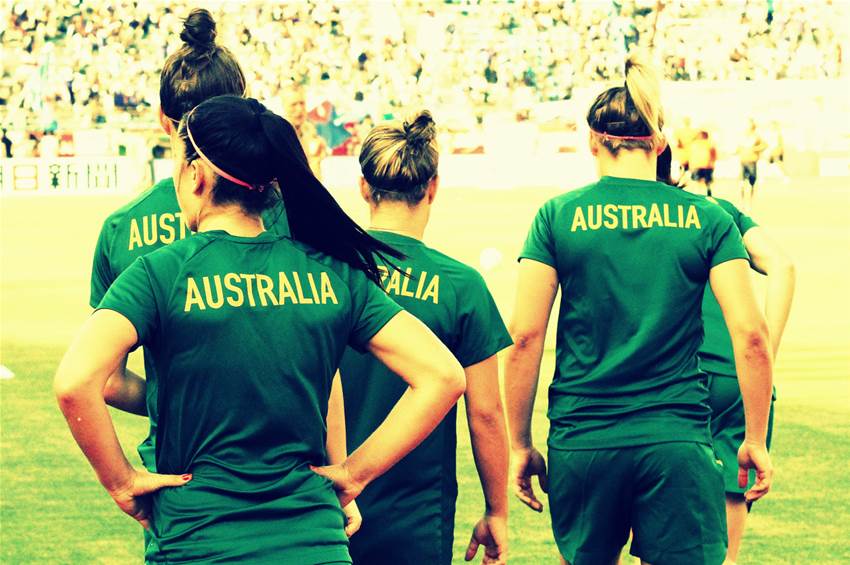On Thursday, 17 April 2014 the 15 month tenure of Hesterine de Reus, the Matildas first female head coach, ended with little fanfare and even less explanation.
On Thursday, 17 April 2014 the 15 month tenure of Hesterine de Reus, the Matildas first female head coach, ended with little fanfare and even less explanation.
The 121 word statement from Football Federation Australia (FFA) left all invested in Australian women's football, be they coaches, administrators, former players or fans, unsatisfied, demanding answers and asking what led to this point.
The Women's Game have had a week to speak with various people involved in the game and the truthful answer is that we don't wholly know why de Reus is gone.
There doesn't appear to be any one main reason or key decision for her departure but a general culmination of incidences that changed the mood of the camp throughout the 15 months, resulting in the players contacting the PFA in early April.
We can’t pretend to outline or have the facts because the ‘facts’ from one source to another differ so that finding the middle ground of where the possible truth lies is difficult.
However the overwhelming theme is a breakdown in communication and trust between various cogs in the national team machine; between de Reus and the players, coaching staff and FFA management.
The chasm
While the dissatisfaction of many in the playing group was the most visible through representation from Professional Footballers Australia (PFA), it also appears incorrect to describe this as a homogeneous player revolt, our discussions found that there was also discontent within support staff and management.
What is known is that, as previously reported, the tension within the camp was longstanding and noted by observers outside of the camp.
"This was never a witch hunt. They were matters that were raised and were so broad in their nature that it wasn't pointing fingers at just the head coach, or assistant."
There were a number of factors contributing to the tensions with the early April reporting concentrating on the players’ displeasure with the coaching and management style of de Reus.
Criticism was directed at the players, including from former Matildas, for an inability to come to terms with what de Reus required from them on and off the pitch. Sharp criticism was also levelled at the players in relation to attitude and professionalism.
The PFA, in a full statement, refuted those criticisms with CEO Adam Vivian, on behalf of the players, stating:
“The PFA and the players remain committed to the objective of establishing a fully professional high performance culture within women’s football.”
“Contrary to the recent media speculation, the dispute is not about negotiating additional payments or resistance on the part of the players to greater professionalism.”
“The players are seeking improved levels of performance and accountability, not less, as the recent performances against Brazil demonstrate.”
“The application of the professional workplace standards is therefore non-negotiable."
The statement then went on to outline the matters raised by the players including:
· unilateral imposition of workplace conditions in breach of the CBA;
· the failure to contract agreed player payments in the manner prescribed in the CBA;
· the development of a lawful Parental Management Policy;
· concerns for player health and safety;
· intimation of non-selection if players take overseas contracts;
· scheduling and workload concerns, including non-adherence to industrial standards; and
· disregard for player wellbeing and development and commitments outside of the game.
While extensive, it is also questionable whether all of the matters outlined were in the sole control of de Reus or any head coach, particularly with regard to player payments and a Parental Management Policy.
Further, with a list this exhaustive and complaints deemed so serious that investigation was required, why was de Reus not aware of them as she maintained at press conferences during the Brazil series.
If this was the case, then it raises questions in relation to the lines of communication within the team and also with the involvement of FFA management. It also speaks to the significant lack of trust between the various parties.
“It’s extraordinary that it got to the level that it did get to or was allowed to get to that level,” said former Matildas captain Julie Dolan on ABC News Radio.
“Why wasn’t there any intervention prior to this point?”
It’s a good question. Surely someone should have had awareness of the issues that were percolating and there should have been an intervention or mediation before the situation reached boiling point.
When asked by The Women's Game if the players had asked for the dismissal of de Reus, Vivian was emphatic in his answer.
"No, they hadn't asked for the removal [of de Reus]," he stated.
"What they had said was that these are their concerns and they would like those concerns addressed in a timely fashion."
"This was never a witch hunt. They were matters that were raised and were so broad in their nature that it wasn't pointing fingers at just the head coach, or assistant."
"It was a statement of these are the expectations of what the players have fought really hard to achieve and they would like to see them implemented and honoured."
Once the investigation was launched there seemed to be no way back for Hesterine de Reus.
Point of no return
Hopefully Matildas players and ex-coach talk publicly about what happened. Transparency is needed so we don't have a repeat situation
— Lee Gaskin (@Lee_Gaskin1) April 17, 2014Whether it was the message or the manner of delivery, what is now patently clear is that the situation hurtled towards the conclusion, de Reus did not have many supporters.
When news of unrest was first reported on Friday, 4 April 2014, there was little coming out from the FFA, de Reus' employers, and it took almost another 48 hours for there to be a full public statement.
Even then, the statement from FFA CEO David Gallop during half time in the Matildas match against Brazil did not exactly convey confidence in or support for de Reus.
“We will put a report together as quickly as possible,” he said. “We'll work out how to take it forward from there.”
“At the moment we are getting on top of these concerning reports. We'll make sure we do a thorough job on that first.”
From there it seems as if the point of no return was very quickly reached.
In compiling the report approximately 20 - 25 players were interviewed with the contents described as ‘damning’.
De Reus then met with management on a number of occasions in the following days but it is alleged that, while the broad contents were discussed, de Reus did not have the opportunity to answer or seek to resolve the issues raised.
The report, with its recommendation to terminate Hesterine de Reus’ contract, was then tabled and the recommendation endorsed at a board meeting.
The question has to be, particularly in light of the speed of developments, was there any dispute resolution process in place and if so was it complied with.
It is not just a question that needs to be answered in relation to the events of the past four weeks (although there may be questions of process to be answered) but also for future Matildas coaches if the same situation were to arise again.
Since then there has been silence. No opportunity to ask further questions, no prospect of additional information or clarification.
Collateral damage
As with any civil unrest, there is usually collateral damage and this skirmish has proved no different.
The PlayersA player revolt in its purest sense or not, there is no disputing the fact that the brand of the Matildas has taken a hit, or at least some of the shine has been rubbed off.
This at a time when the team, and the supporters, should have been happily preparing to repeat one of the nation’s proudest football moments.
Deserved or not, the narrative in Australia and abroad, irrespective of the merits of their claims, has been about privileged and spoilt players bringing about the downfall of a coach.
While it is a narrative that has been played out in sport time and again, just look at the recent situations with the US Women’s National Team and with Manchester United just this month, it has seen caused scratches that will take time to be repaired.
Then there is the possible precedent that has been set in relation to the “player power”. What does this mean for the next permanent coach that comes in? Will they be hesitant to make changes for fear of being ousted?
What happens on the next occasion there is a chasm between players, staff and a coach or this a ‘once only’ event that the FFA learns from and makes steps to ensure it is never repeated.
The ProgramAt the 2011 FIFA Women’s World Cup, Australia had the youngest average age of the eight quarter-finalists.
There was rightfully optimism in regards to the progress of the team and their chances of making it further in the 2015 WWC and possibly medalling.
As it currently stands that optimism is no longer present and it remains to be seen how the program recovers for the Asian Cup defence.
One small mercy is that AFC places for the 2015 WWC have been increased from 3 to 5.
Female CoachesAlthough the representative national teams had seen one or two female coaches at the helm, Hesterine de Reus was the first female head coach for the senior side.
That her tenure has ended in the manner it has may result in reluctance or hesitance for FFA to appoint a female coach in the future.
This is on top of the obstacles female coaches already face including paying for and obtaining the relevant coaching licences, gaining experience at the elite level as assistants and gaining appointments in head coaching positions be it at local, state or national level.
Yes, the head coach of the Matildas should be the best person for the position regardless of gender, however, this is an obvious set back for the current coaches in the system and the road to the top of the game has been made that little rockier.
2019 FIFA Women’s World CupWhile nothing was officially released about possibly bidding from the FFA, the Matildas situation did not help.
Sadly, this was probably Australia’s best chance of hosting a senior world cup (men's or women's), particularly as more countries invest into and realise the potential of women’s football.
South Korea, South Africa and France have all formally bid for 2019 and with Japan in the frame for 2023, it will be a while before Australia gets another chance and by then the competition will be greater.
What now?
The next couple of months are crucial months for the women’s game in Australia with qualification for the 2015 Women’s World Cup at the forefront.
Then the search for a new permanent head coach commences, taking on greater significance and urgency a year out from a World Cup.
Alongside that search is the upcoming national team review. Hopefully that review takes a thorough look at what has occurred in the past 15 months, answers questions of how the situation evolved to the point of no return and puts in place appropriate systems to guard against a repeat.
There are also many other issues including the future of the W-League (which is currently under review), the technical direction of the game (does it continue to fall in line with the men or have a separate technical director in control), implementation of the Women’s Football Strategy and the structure of the underpinning programs of the national team.
What happens in the next couple of months could very well impact women’s football for the next decade.
Related Articles

'Timing not right': Montemurro's verdict on Matildas vacancy
.jpg&h=172&w=306&c=1&s=1)
Matildas star ready for epic return after 'really difficult' journey













